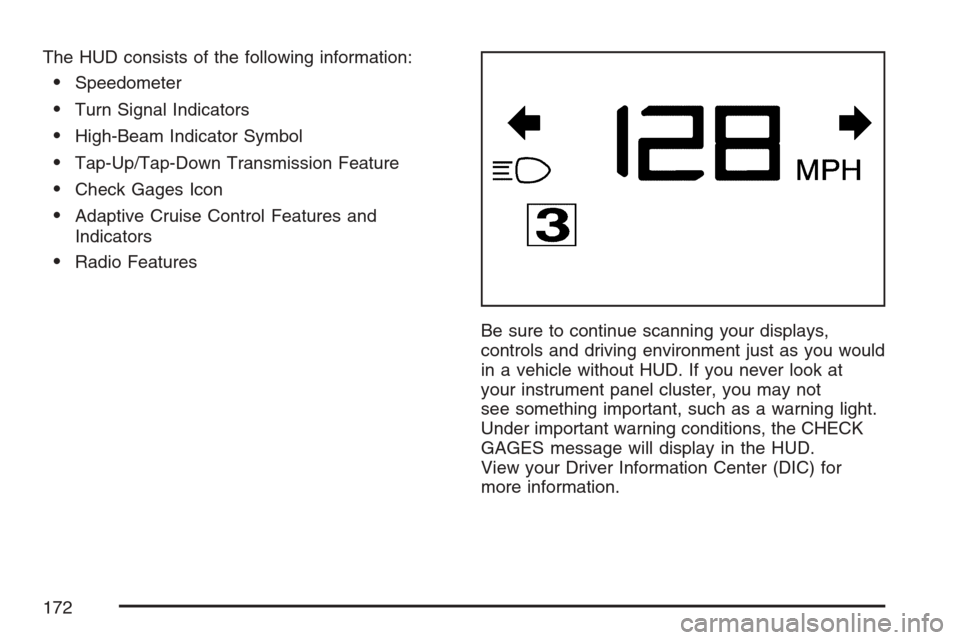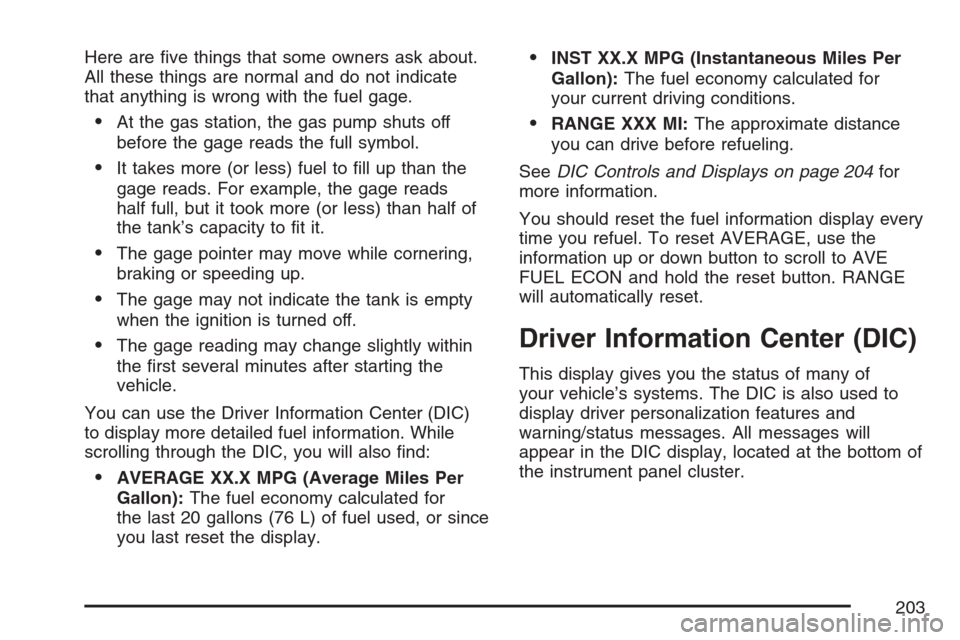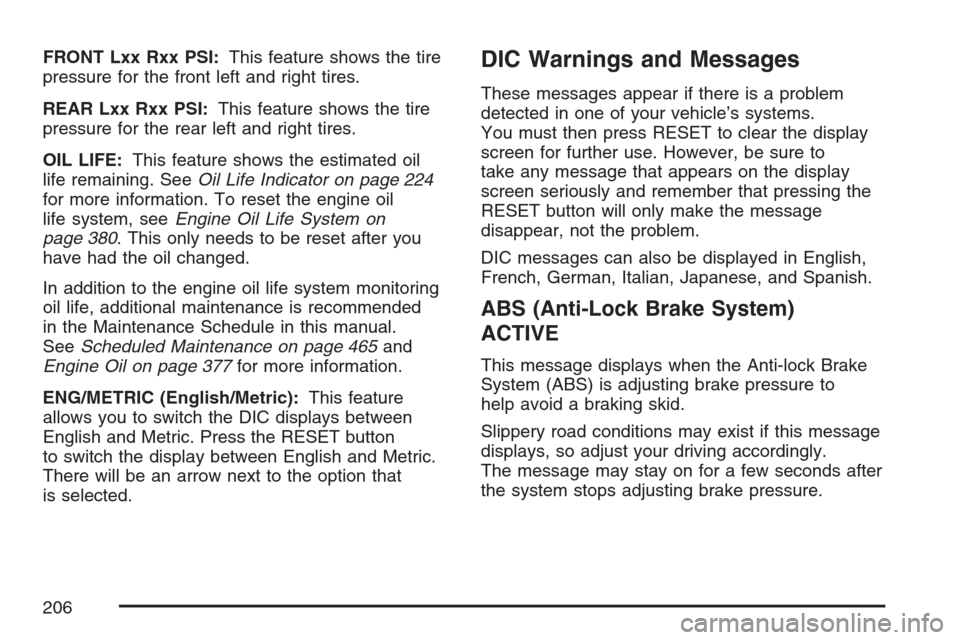warning CADILLAC XLR V 2007 1.G Owner's Manual
[x] Cancel search | Manufacturer: CADILLAC, Model Year: 2007, Model line: XLR V, Model: CADILLAC XLR V 2007 1.GPages: 512, PDF Size: 3.84 MB
Page 172 of 512

The HUD consists of the following information:
Speedometer
Turn Signal Indicators
High-Beam Indicator Symbol
Tap-Up/Tap-Down Transmission Feature
Check Gages Icon
Adaptive Cruise Control Features and
Indicators
Radio Features
Be sure to continue scanning your displays,
controls and driving environment just as you would
in a vehicle without HUD. If you never look at
your instrument panel cluster, you may not
see something important, such as a warning light.
Under important warning conditions, the CHECK
GAGES message will display in the HUD.
View your Driver Information Center (DIC) for
more information.
172
Page 185 of 512

Warning Lights, Gages, and
Indicators
This part describes the warning lights and gages
that may be on your vehicle. The pictures will
help you locate them.
Warning lights and gages can signal that
something is wrong before it becomes serious
enough to cause an expensive repair or
replacement. Paying attention to your warning
lights and gages could also save you or others
from injury.
Warning lights come on when there may be or is a
problem with one of your vehicle’s functions. As
you will see in the details on the next few
pages, some warning lights come on brie�y when
you start the engine just to let you know they
are working. If you are familiar with this section,
you should not be alarmed when this happens.Gages can indicate when there may be or is a
problem with one of your vehicle’s functions. Often
gages and warning lights work together to let
you know when there is a problem with your
vehicle.
When one of the warning lights comes on and
stays on when you are driving, or when one of the
gages shows there may be a problem, check
the section that tells you what to do about
it. Please follow this manual’s advice. Waiting to
do repairs can be costly — and even dangerous.
So please get to know your warning lights and
gages. They are a big help.
Your vehicle has a Driver Information Center that
works along with the warning lights and gages.
SeeDriver Information Center (DIC) on page 203
for more information.
185
Page 186 of 512

Instrument Panel Cluster
Your instrument panel cluster and Driver Information Center (DIC) are designed to let you know at a
glance how the vehicle is running. You will know how fast you are going, about how much fuel you have
left and many other things you will need to know to drive safely and economically. The instrument
panel cluster indicator warning lights, gages and DIC messages are explained on the following pages.
United States Base Cluster shown, Canada and Uplevel similar
186
Page 192 of 512

Voltmeter Gage
When the vehicle is in
accessory mode, the
voltmeter shows
the voltage output of
your battery. When the
engine is running, it
shows the voltage
output of the charging
system.
The reading will change as the rate of charge
changes (with engine speed, for example), but if
the voltmeter reads at 9 volts or below, your
instrument panel cluster and other systems may
shut down. The Driver Information Center (DIC) will
read LOW VOLTAGE when your vehicle is at
10 volts or below. Have it checked right away.
Driving with the voltmeter reading at 10 volts
or below could drain your battery and disable your
vehicle.
Brake System Warning Light
Your vehicle’s hydraulic brake system is divided
into two parts. If one part is not working, the other
part can still work and stop you. For good
braking, though, you need both parts working well.
This light should come on when you start the
engine. If it does not come on then, have it �xed
so it will be ready to warn you if there is a problem.
If this warning light stays on after you start the
engine, the parking brake may still be set or there
could be a brake problem. Refer toParking
Brake on page 97to see if it is set. If the parking
brake is not set, have your brake system
inspected right away.
United StatesCanada
192
Page 193 of 512

If the light comes on while you are driving and you
have a LOW BRAKE FLUID message showing
on the DIC, pull off the road and stop carefully.
You may notice that the pedal is harder to
push. Or, the pedal may go closer to the �oor. It
may take longer to stop. If the light is still on, have
the vehicle towed for service. SeeTowing Your
Vehicle on page 359.
{CAUTION:
Your brake system may not be working
properly if the brake system warning light
is on. Driving with the brake system
warning light on can lead to an accident.
If the light is still on after you have pulled
off the road and stopped carefully, have
the vehicle towed for service.
Anti-Lock Brake System Warning
Light
With the Anti-Lock
Brake System (ABS),
this light will come
on when your engine is
started and may stay
on for several seconds.
That is normal.
If the light stays on, turn the ignition off or if the light
comes on when you are driving, stop as soon as
possible and turn the ignition off. Then start the
engine again to reset the system. If the light still
stays on, or comes on again while you are driving,
your vehicle needs service. If the regular brake
system warning light is not on, you still have brakes,
but you do not have anti-lock brakes. If the regular
brake system warning light is also on, you do not
have anti-lock brakes and there is a problem with
your regular brakes. See “Service ABS” underDIC
Warnings and Messages on page 206.
The ABS warning light will come on brie�y when
you turn the ignition on. This is normal. If the
light does not come on then, have it �xed so it will
be ready to warn you if there is a problem.
193
Page 194 of 512

Traction Control System (TCS)
Warning Light
This light should come
on brie�y as you start
the engine.
If the light does not come on then, have it �xed so
it will be ready to warn you if there is a problem.
The light will also come on while the StabiliTrak
®
system warms up and the STABILITRAK
WARMING message will be displayed in the
Driver Information Center (DIC).
If it stays on, or comes on and the DIC shows a
SERVICE TRACTION SYS message when you are
driving, there is a problem with your Traction
Control System (TCS) and your vehicle needs
service. When this light is on, the system will not
limit wheel spin. Adjust your driving accordingly.If the driver turns off TCS by pressing the button
on the console, the TCS light will come on and the
TRACTION SYSTEM OFF message will show
on the DIC.
If the light stays on or comes on while you are
driving, a chime sounds and a SERVICE
STABILITRAK message appears on the DIC,
there is a problem with your StabiliTrak
®and the
vehicle needs service.
You can acknowledge this message by pressing
the RESET button. When the SERVICE
STABILITRAK message is displayed, the
StabiliTrak
®system will not assist you in
controlling the vehicle. You should have the
system serviced as soon as possible. Adjust your
driving accordingly.
When the system is working, you will see the
STABILITRAK ACTIVE message displayed in the
DIC. You may also feel of hear the system
working. This is normal.
194
Page 195 of 512

If you turn off the StabiliTrak®system, by pressing
the front part of the button on the console for
�ve seconds, the TCS light will come on, a chime
will sound and the TRAC/STABILITRAK OFF
message will be displayed in the DIC. The TCS
will also be turned off. SeeDIC Warnings and
Messages on page 206for more information.
If the StabiliTrak
®system and TCS are turned off,
pressing the console button momentarily will
turn both systems on. The DIC will display the
TRAC/STABILITRAK ON message, the instrument
cluster light will be off and a chime will sound.
SeeDIC Warnings and Messages on page 206for
more information.
Engine Coolant Temperature Gage
This gage shows the engine coolant temperature.
As the pointer nears 260°F (125°C), your
engine coolant temperature is high. A message
may display on the Driver Information Center (DIC)
depending on how high the temperature is. See
DIC Warnings and Messages on page 206
for more information.
SeeEngine Overheating on page 388for more
information.
United StatesCanada
195
Page 200 of 512

Your vehicle will not pass this inspection if the
OBD (on-board diagnostic) system determines that
critical emission control systems have not been
completely diagnosed by the system. The vehicle
would be considered not ready for inspection.
This can happen if you have recently replaced the
battery or if the battery has run down. The
diagnostic system is designed to evaluate critical
emission control systems during normal driving.
This may take several days of routine driving.
If you have done this and your vehicle still does
not pass the inspection for lack of OBD system
readiness, your dealer can prepare the vehicle for
inspection.Engine Oil Pressure Gage
The engine oil pressure gage shows the engine oil
pressure in psi (pounds per square inch) or kPa
(kilopascals) when the engine is running.
Oil pressure should be 20 to 80 psi
(140 to 550 kPa). In certain situations such as
long, extended idles on hot days, it could read as
low as 6 psi (40 kPa) and still be considered
normal. It may vary with engine speed, outside
temperature and oil viscosity. The Driver
Information Center (DIC) may display messages
regarding the oil condition. SeeDIC Warnings and
Messages on page 206andEngine Oil on
page 377.
United StatesCanada
200
Page 203 of 512

Here are �ve things that some owners ask about.
All these things are normal and do not indicate
that anything is wrong with the fuel gage.
At the gas station, the gas pump shuts off
before the gage reads the full symbol.
It takes more (or less) fuel to �ll up than the
gage reads. For example, the gage reads
half full, but it took more (or less) than half of
the tank’s capacity to �t it.
The gage pointer may move while cornering,
braking or speeding up.
The gage may not indicate the tank is empty
when the ignition is turned off.
The gage reading may change slightly within
the �rst several minutes after starting the
vehicle.
You can use the Driver Information Center (DIC)
to display more detailed fuel information. While
scrolling through the DIC, you will also �nd:
AVERAGE XX.X MPG (Average Miles Per
Gallon):The fuel economy calculated for
the last 20 gallons (76 L) of fuel used, or since
you last reset the display.
INST XX.X MPG (Instantaneous Miles Per
Gallon):The fuel economy calculated for
your current driving conditions.
RANGE XXX MI:The approximate distance
you can drive before refueling.
SeeDIC Controls and Displays on page 204for
more information.
You should reset the fuel information display every
time you refuel. To reset AVERAGE, use the
information up or down button to scroll to AVE
FUEL ECON and hold the reset button. RANGE
will automatically reset.
Driver Information Center (DIC)
This display gives you the status of many of
your vehicle’s systems. The DIC is also used to
display driver personalization features and
warning/status messages. All messages will
appear in the DIC display, located at the bottom of
the instrument panel cluster.
203
Page 206 of 512

FRONT Lxx Rxx PSI:This feature shows the tire
pressure for the front left and right tires.
REAR Lxx Rxx PSI:This feature shows the tire
pressure for the rear left and right tires.
OIL LIFE:This feature shows the estimated oil
life remaining. SeeOil Life Indicator on page 224
for more information. To reset the engine oil
life system, seeEngine Oil Life System on
page 380. This only needs to be reset after you
have had the oil changed.
In addition to the engine oil life system monitoring
oil life, additional maintenance is recommended
in the Maintenance Schedule in this manual.
SeeScheduled Maintenance on page 465and
Engine Oil on page 377for more information.
ENG/METRIC (English/Metric):This feature
allows you to switch the DIC displays between
English and Metric. Press the RESET button
to switch the display between English and Metric.
There will be an arrow next to the option that
is selected.DIC Warnings and Messages
These messages appear if there is a problem
detected in one of your vehicle’s systems.
You must then press RESET to clear the display
screen for further use. However, be sure to
take any message that appears on the display
screen seriously and remember that pressing the
RESET button will only make the message
disappear, not the problem.
DIC messages can also be displayed in English,
French, German, Italian, Japanese, and Spanish.
ABS (Anti-Lock Brake System)
ACTIVE
This message displays when the Anti-lock Brake
System (ABS) is adjusting brake pressure to
help avoid a braking skid.
Slippery road conditions may exist if this message
displays, so adjust your driving accordingly.
The message may stay on for a few seconds after
the system stops adjusting brake pressure.
206